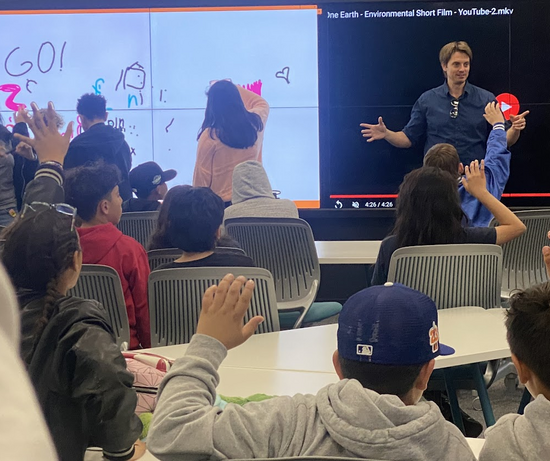With a touch of the screen, new interactive video technology at UC Riverside’s XCITE Center for Teaching and Learning allows students to explore countless learning opportunities.
The giant 27-foot diagonal screen occupies a central location in front of couches and desks at the center, located at Tomás Rivera Library. The Immersive Design for Educational Advancement, or IDEA, Wall was installed last fall, with instructors offered the opportunity to test out its uses over the past year.
“We see this as one of the ways to think about the future of teaching and engagement,” said Richard Edwards, executive director of XCITE. “What we’re seeing with this high visualization wall and similar interactive touchscreen-based technologies, demonstrates a model of what we anticipate may replace ceiling projectors and screens in classroom design over the next 10 years.”
Richard Edwards, executive director for the XCITE Center for Teaching and Learning, demonstrates the high visualization wall located in the XCITE Commons, to a group of high school students attending a summer camp on Thursday, June 15, 2023. (UCR/Stan Lim)
The project came together as a partnership between XCITE, also known as the Exploration Center for Innovative Teaching and Engagement, Information Technology Solutions Research Computing, and a physics professor.
The IDEA Wall is made of up 12 high-quality video screens bordered by an infrared grid that creates a touch panel that can be used by 25 simultaneous users. The wall features a surround sound system with two subwoofers and left, center, and right speakers. It’s connected to a 5G high-speed network, runs on a high-performance research computer, and has its own server room with a power rack and cooling system behind the wall.
It’s at once a super-fast computer, a large display screen, and a giant iPad, among other things, depending on how instructors and students see fit to use it.
For example, users can click on a 360-degree YouTube video that provides a virtual tour of the Parthenon, moving around the video angle with their fingers.
“As you move, you’re moving the video,” Edwards said. “It can create an immersive experience that allows for a deeper and more engaging exploration of a historical site in Athens, Greece.”
Another use of the wall is to display a map with data such as weather conditions or population and expand or move around to focus on a particular region. Medical students can use it to explore anatomy while math students can solve equations, said Israel Fletes, XCITE’s director of academic technology.
It can be also used as a giant whiteboard where students can write their thoughts or work on problems together, he said. It features as its backdrop T1V’s ThinkHub digital canvas, which users can expand up to 20 times the surface area of the physical touchscreen.
The idea and funding for the IDEA Wall came from a NASA grant that Bahram Mobasher, a UCR professor of physics and observational astronomy, helped secure.
“In order to teach we need to be innovative,” Mobasher said, comparing it to a visual laboratory. “Instead of going to Mars, we are bringing Mars to you.”
In June, Mobasher hosted a six-week STEM summer camp, funded through a NASA educational grant, using the IDEA Wall to teach about 40 high school students a variety of science topics ranging from computer coding to virtual reality.
The room has been available for faculty members and teaching assistants to use for office hours.
Joshua Hartman, an assistant teaching professor of chemistry, was among the first to make use of it.
“It was a big hit from the beginning,” he said.
Students enjoyed the flexibility of being able to hang out in a casual space, sitting on the couch, or working together on the wall. Hartman said he soon saw the number of students stopping in for office hours increasing.
Students found it very intuitive to use, starting first with basic functions before progressing to more advanced uses such as video simulations.
“It’s really created a collaborative space for students to work together,” Hartman said.
Joshua Hartman, an assistant teaching professor of chemistry, uses the IDEA Wall for office hours. (Photo courtesy Joshua Hartman)
AUTHOR: IMRAN GHORI
